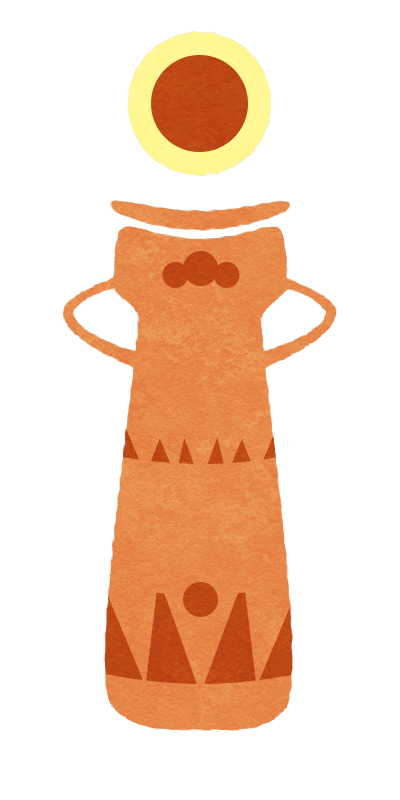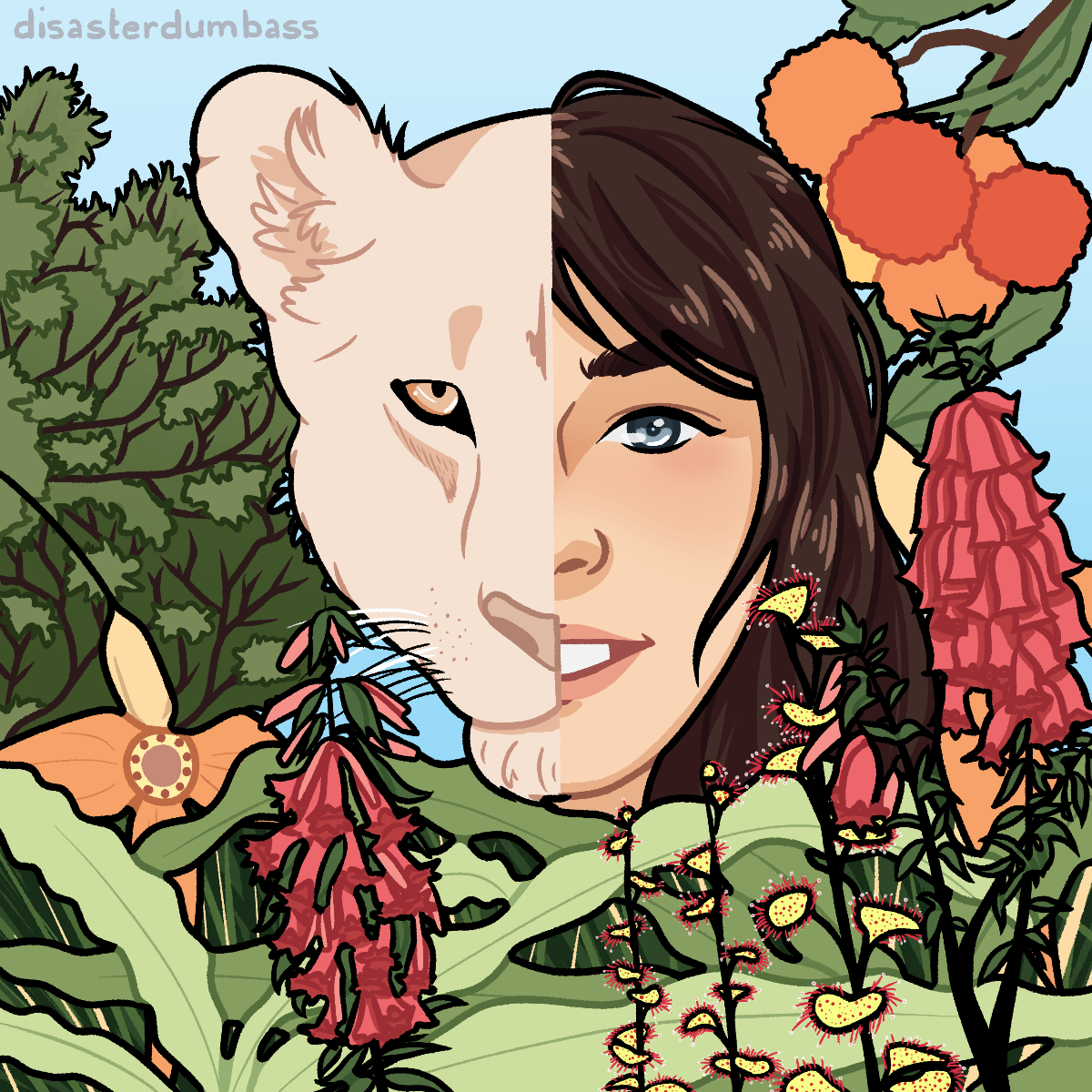Coastal Habitation
Their predators cannot swim, and so, the Linnh's long legs and elongated, webbed extremities allow them to swim to safety should they be pursued. Their hairless khaki brown skin is slightly rubbery to the touch, and seems to enable them to swim faster.
Their enlarged eyes are dyed a bright red, mimicking the bright colors of other poisonous creatures living in the rainforest. Their eyelids rest half-closed— so that when faced with danger, they can quickly open and startle predators— giving them more time to flee. Linnh typically stand from 6'4" to 6'11".
On the tops— not the sides— of their heads sprouts short, thin, dark-blue, dark-green, or dark-brown hair. In a coming-of-age ceremony— the eyahdve— Linnh have their teeth pulled out and replaced with those of the very predators they seek to avoid, and their cheeks cut at the corners of their mouths, giving them permanent fanged smiles. They believe this to scare away their predators.
The Never-Ending Hunt
The strange, abhorrent creature rippled like water— and split into many, smaller creatures like itself which scattered from the village. The creature later reformed, and tried again— this time slaughtering a number of families before being faced with a man practicing the instrument— and it split once again. The Viehl learned from this event, and began to have their musicians keep watch as the beast moved on to the next tribe. Eventually, the few surviving tribes fled to join the Viehl— and the creature's assaults became more frequent. Somehow— defying explanation— the beast appears within minutes of the music stopping— prompting a constant patrol of musicians along the newly formed nation of Hanviehl's borders to be set.
Traditions
Greetings & Farewells
When greeting a fellow Linnh, one cups their hand and waves it upwards over their face. Farewells are the opposite, waving downwards. For outsiders they have yet to become close with, a simple long-held blink is used for both.Milestones
Birth
The child's father will stay at his partner's side, and play music softly through a lightly closed fist to her swollen belly— believing to be coaxing the child into the world. The song chosen is believed to play a significant role in determining the child's personality. A frantic, energetic song will cause the child to be just that, and a calm, soothing song will have the opposite effect.Close family and friends will arrive the day after to celebrate with the new parents, playing music, bearing gifts, and all will stay around to see the parents present the child with their first instrument— a short wooden tube with a flat end to keep from being swallowed called a Ceh.
Coming of age
At the age of 8, Linnh undergo the Eyahnvell— a ceremony where they have their teeth pulled out, ground to a paste, and used to promote bone growth and join with those of the Ahndel Veha which take their place. Their cheeks are then cut at the corners of their mouths, giving them permanent fanged smiles. They believe the visage this gives them to scare away their numerous predators.Death
When a Linnh dies, someone close to them will remove the body's eyes and implanted teeth. The teeth can be used for another, without the need of a dangerous hunt. It is somewhat common to see teeth carried down for generations. The eyes will be placed on a tiny wooden boat and pushed out into the sea, looking upwards at the sky. The rest of the body is taken to a dedicated burial site along the coast, and sunk to the bottom with stones.Eating
Warm water accompanies almost every meal, and must be sipped before taking any bites of one's food, and finished before the meal is done.War
The Linnh have a surprising lack of war in their history, while the original, separated tribes may have had battles from time to time— once the Ahndel Veha awoke, it was too great a risk. Even foreign nations, such as Louh, who first came into contact with Hanviehl, did not invade— given the ever-present danger the beast poses.None but those who have grown accustomed to this lifestyle would desire such an ever-present danger at their doorsteps.
However, the Linnh do send out hunting parties periodically to splinter pieces from Ahndel Veha and vanquish them. It is hoped that one day they may finally put an end to the complete horror once and for all, but this seem unlikely.
Ideals, Love & Gender
Relationships
Relationships for the Linnh are strictly between a man and a woman, it is believed that both are two halves of the same eternal song, and to combine two of the same half is to create cacophony. Marriage is only decided when a woman becomes pregnant, though partners may stay together regardless. These events, like birth, are attended by close friends and family, who sing and dance to celebrate the occasion.Beauty
Men tie ornaments such as shells, polished coral, or even wooden beads to their short hair. Women will cover the apex of their heads with a single, larger object such as a shell or polished wood.Gender
Men are expected to be proficient in at least one instrument by the time they reach adulthood, and women are expected to sing. Men take care of children at home, should any exist, but both parties are ultimately able to find the same jobs.Art, Architecture, and Dress
Art
Entire schools of music have developed within the nation, from acapella singers, to wind instruments and strings, to entire orchestral arrangements— each with their own groups of written works passed down and iterated upon through generations.
Seashell art is popular, as well, where a collection of shells, corals, and stones are arranged into beautiful shapes and forms on a flat plate. More often than not, these are temporary works— sometimes left in the open for others to come across and enjoy, or even adjust to their own liking. Some areas have communal works for all to collaborate on, as well.
Architecture
Linnh settlements are riddled with a series of interconnecting canals, rather than roads. As their bodies are better suited for swimming than walking, this is simply more convenient. Not only this— but the water acts as an extra barrier should the music wane, and Ahndel Veha breach the walls.Their construction is heavily wood-based— often, even their foundations are built from pilings of wood. Buildings are typically triangular in shape, to conserve material, with the ends of boards often reaching over the apex of the structure, creating a small V along the uppermost edges of their roofs. Mud brick is often fired and placed around structures for extra support. Doorways will often open directly over canals, on occasion there will be dock-like pathways alongside canals.
Dress
Given their constant need to swim, most Linnh do not wear clothing. Those who meet with outsiders sometimes will don clothing akin to their own, to give them more comfort, but that is all.Religion & Myth
Lihn
Naming
Linnh naming conventions are one and the same with those of their language, Lhehd.Family names are derived from a melody always played at birth, while first names are based off of the sounds heard in the song during the moment one is born.
Taboos
A song cannot go unfinished, once one starts, they are obligated to complete it. Should you leave a song unfinished, it is believed that it will well up within your lungs and burst forth.Song of the shore
For Linnh who travel away from their home, there is a song that is believed to carry the spirit of their homeland. This is oft hummed when homesickness finds them.O'er the winded sho~res;
'ast the crashing wa~ves;
'Dohe~!'
She cries, and bra~ves;
'cross the cacophony~;
'Dohe~!'
She wails, and cra~ves;
that soft voice, agai~n;
forever lost to~;
hi~s gra~ve.








OH! A bard people. This speaks to my soul on levels i cant quite put into words. This... This is art. I love that you created an instrument for them. I also love that they are named after songs (if i understand correctly) and the birth process actually has scientific basis. The sounds an infant hears in the womb has shown to possibly effect them. Excellent touch! Now i'm trying to see a negative or constructive criticism here and I really cant. They are now my favorite. I do wonder... in architecture you don't seem to mention acoustics as being a factor. is it? "Men are expected to be proficient in at least one instrument by the time they reach adulthood, and women are expected to sing." I found this interesting as well. why is it? just curious if there is a reason in particular.
Thanks for the kind words! Glad you like them! You'll likely enjoy the article on their country, as well, Hanviehl, which is linked in here!
Acoustics are mostly a factor in the orchestral halls, and the towers which musicians play from along the edges of their settlements. Hard to account for acoustics in every structure when you've got limited building materials!
As to why the gender expectations differ, it is not known currently. Perhaps someone saw a couple, where the man was best with their instruments, and the woman with her voice— and this slowly but surely got overblown into myth and codified in their culture.
oh thats fair lol. lacking materials can be detrimental. The gender stuff is also fair. lol ill check out the country here. im curious